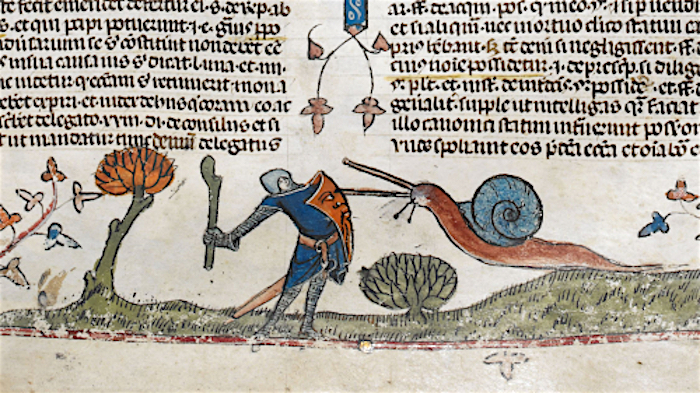Although it’s certainly more plausible than hypotheses like ancient aliens or lizard people, the idea that slaves built the Egyptian pyramids is no more true. It derives from creative readings of Old Testament stories and technicolor Cecil B. Demille spectacles, and was a classic whataboutism used by slavery apologists. The notion has “plagued Egyptian scholars for centuries,” writes Eric Betz at Discover. But, he adds emphatically, “Slaves did not build the pyramids.” Who did?
The evidence suggests they were built by a force of skilled laborers, as the Veritasium video above explains. These were cadres of elite construction workers who were well-fed and housed during their stint. “Many Egyptologists,” including archaeologist Mark Lehner, who has excavated a city of workers in Giza, “subscribe to the hypotheses that the pyramids were… built by a rotating labor force in a modular, team-based kind of organization,” Jonathan Shaw writes at Harvard Magazine. Graffiti discovered at the site identifies team names like “Friends of Khufu” and “Drunkards of Menkaure.”
The excavation also uncovered “tremendous quantities of cattle, sheep, and goat bone, ‘enough to feed several thousand people, even if they ate meat every day,’ adds Lehner,” suggesting that workers were “fed like royalty.” Another excavation by Lehner’s friend Zahi Hawass, famed Egyptian archaeologist and expert on the Great Pyramid, has found worker cemeteries at the foot of the pyramids, meaning that those who perished were buried in a place of honor. This was incredibly hazardous work, and the people who undertook it were celebrated and recognized for their achievement.
Laborers were also working off an obligation, something every Egyptian owed to those above them and, ultimately, to their pharaoh. But it was not a monetary debt. Lehner describes what ancient Egyptians called bak, a kind of feudal duty. While there were slaves in Egypt, the builders of the pyramids were maybe more like the Amish, he says, performing the same kind of obligatory communal labor as a barn raising. In that context, when we look at the Great Pyramid, “you have to say ‘This is a hell of a barn!’’’
The evidence unearthed by Lehner, Hawass, and others has “dealt a serious blow to the Hollywood version of a pyramid building,” writes Shaw, “with Charlton Heston as Moses intoning, ‘Pharaoh, let my people go!’” Recent archeology has also dealt a blow to extraterrestrial or time-travel explanations, which begin with the assumption that ancient Egyptians could not have possessed the know-how and skill to build such structures over 4,000 years ago. Not so. Veritasium explains the incredible feats of moving the outer stones without wheels and transporting the granite core of the pyramids 620 miles from its quarry to Giza.
Ancient Egyptians could plot directions on the compass, though they had no compasses. They could make right angles and levels and thus had the technology required to design the pyramids. What about digging up the Great Pyramid’s 2 million blocks of yellow limestone? As we know, this was done by a skilled workforce, who quarried an “Olympic swimming-pool’s worth of stone every eight days” for 23 years to build the Great Pyramid, notes Joe Hanson in the PBS It’s Okay to Be Smart video above. They did so using the only metal available to them, copper.
This may sound incredible, but modern experiments have shown that this amount of stone could be quarried and moved, using the technology available, by a team of 1,200 to 1,500 workers, around the same number of people archaeologists believe to have been on-site during construction. The limestone was quarried directly at the site (in fact the Sphinx was mostly dug out of the earth, rather than built atop it). How was the stone moved? Egyptologists from the University of Liverpool think they may have found the answer, a ramp with stairs and a series of holes which may have been used as a pulley system.
Learn more about the myths and the realities of the builders of Egypt’s pyramids in the It’s Okay to Be Smart “Who Built the Pyramids, Part 1″ video above.
Note: An earlier version of this post appeared on our site in 2021.
Related Content:
What the Great Pyramids of Giza Originally Looked Like
A Walking Tour Around the Pyramids of Giza: 2 Hours in Hi Def
Take a 360° Interactive Tour Inside the Great Pyramid of Giza
Take a 3D Tour Through Ancient Giza, Including the Great Pyramids, the Sphinx & More
What the Great Pyramid of Giza Would’ve Looked Like When First Built: It Was Gleaming, Reflective White
The Grateful Dead Play at the Egyptian Pyramids, in the Shadow of the Sphinx (1978)
Josh Jones is a writer and musician based in Durham, NC. Follow him at @jdmagness








